A Guitar That Offers Flexibility and Great Tone
New Old Stock Sterling by Music Man LUKE Series LK100D
Not just another Super Strat...
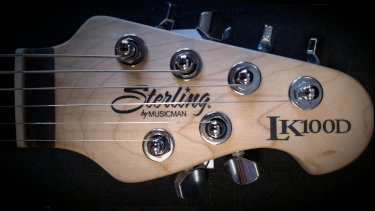
Click to embiggen
01/12/2020
DISCOVERY
I’m not much into signature model guitars. Frankly, I avoid the whole fanboy thing as much as possible. However, I've followed Steve Lukather's career since 1982 and Toto IV.. Last year I got the video, Toto 35th Anniversary: Live in Poland, and Toto XIV, and then got to see him play live in concert with Toto. Over the years I was impressed with his lead style and particularly with some of his right-hand technique on the trem bar while he was playing lead. I’ve been working on adding more expression to the beginnings and ends of my notes during melodic leads and Steve ably showed how that is done with his manipulation of the trem arm. Lukather has been an incredibly prolific and influential guitarist both as a founding member of Toto and as one of the most recorded studio guitarists in history. In the eighties you just about couldn't go through an hour of radio without hearing Steve's work on one or another artist's record. In the nineties, he worked with Ernie Ball Music Man to create a group of instruments that would allow him to get the sounds he wanted using active pickups. At the time he was using racked amplifiers and effects for maximum flexibility. Then a few years ago Steve decided to simplify his life, his rig, and his instruments. In the case of his guitars, that meant leaving active pickups and returning to passive ones. Lukather worked with Larry DiMarzio to create a group of signature pickups named after his latest album, Transition™. He then incorporated those pickups into a new guitar line he designed with the folks at Ernie Ball Music Man. Steve now uses these LUKE guitars exclusively. Seeing Steve play, I became intrigued with these guitars that allowed his technique to be expressed so easily, so I started looking into them.

THE CHASE
With a little research I discovered that Music Man has two lines of Lukather signatures, the U.S.-built Ernie Ball Music Man version and a newer Sterling by Music Man-branded version, both with Steve’s signature DiMarzio Transition™ humbucking pickups. The Sterling brand is a sub-brand of Music Man named after Ernie Ball’s son, Sterling, who purchased the Ernie Ball brand from his father and has continued and grown the company. He instituted the Sterling brand as Music Man’s import brand. Germain to this discussion, Sterling Music Man offers an affordable version of the dual-humbucker model Luke III in the Ernie Ball LUKE line. While I was interested in the sound and features of Steve’s guitars, I wasn’t ready to plunk down the $2250 entry fee for a special-interest guitar. At that point I saw a Sterling “LUKE” signature LK100D pop up used at a local store for a great price and wondered how the build quality was on these guitars. I visited the store and the guitar and was impressed with the guitar’s sound and playability. I was also taught the difference between the LK100D model and the newer “LUKE” model: As of 2019, Sterling decided the LK100D, with the “D” signifying “DiMarzio,” needed to be offered at a lower price point. To do so they deleted the DiMarzio pickups and substituted another set that many feel aren’t nearly as nice. They renamed the resulting model the “LUKE.” The names appear on the headstock. The guitar at the local store was a “Hazel Burst” 2019 “LUKE” that had been modified by retrofitting a set of Transition™ pickups. I was impressed with the feel and sound of the instrument and loved the burst but there were some issues with the guitar’s neck, so I passed on it.
However, I was very impressed with that guitar and it triggered a search on the Internet for a new-old-stock LK100D. During a couple of weeks of searching I found many, many examples listed as LK100Ds but all of them turned out to be the newer LUKE model. I finally stumbled across one solitary “Luke Blue” LK100D far away in a small store. Best I could tell, this was the last new LK100D anywhere. I called up the store and was answered by a happy, gregarious guy named Jimmy. We had a delightful discussion and negotiation on the phone that eventually lead to my purchasing the said example and a hard case a few days later. Thus began the guitar’s 581-mile sojourn to my home via FedEx with me tracking it each day.
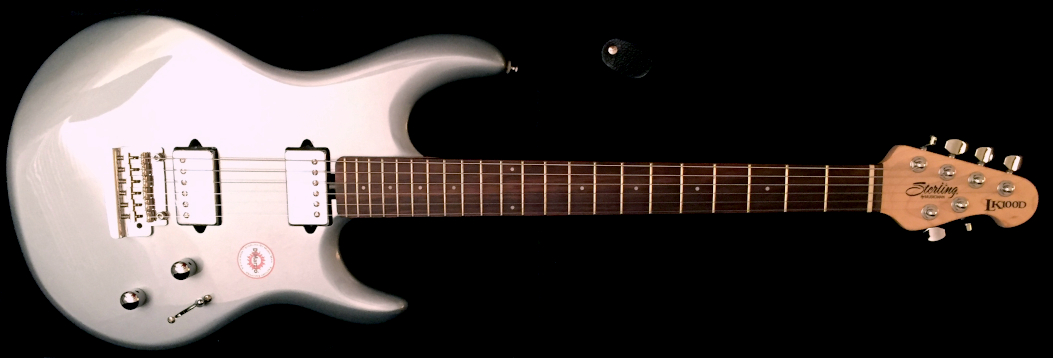
Click to embiggen
ARRIVAL
Jimmy had done a fine job of packing the guitar so it arrived safe and sound. However, the vintage trem tailpiece was standing up pretty high and the strings were tightly wedged in the nut slots, giving me the impression that the nice folks at the store had kindly replaced the strings but had accidentally put too large strings on. Even though it had been kept in a hydrated environment, the guitar had been shipped in winter from a store in a very cold, dry climate (Rochester, NY) so even with the oversized strings the neck had very little relief. I immediately proceeded to replace the strings with my favorite .009 gauge extra lights and the tailpiece settled right down into Steve’s spec of 3mm above the deck.* That left the neck relief to be managed. On this guitar, the truss rod adjuster is a wheel located at the bottom of the neck next to the neck pickup. In the package of case candy there is a four-inch metal rod designed to be inserted into holes around the circumference of the wheel to turn it. The wheel turned smoothly with little effort and allowed me to dial in the right relief quite easily. Once the relief was right, the action height turned out to be perfect as well. The only other issue was that the press-in trem arm flopped loosely when I let go of it. I spent twenty-four hours cooking up klugey solutions in my mind before I stumbled across a little write-up on the Ernie Ball Music Man site that explained everything: If you look up from the lower strap button toward the bridge, you’ll see a small hole in the trem block at the location where the bar rests. Press down on the trem bar a bit to raise that hole above the level of the guitar body. Insert the smaller of the two hex keys that came in the guitar’s goody bag and turn: lefty loosey, righty tighty. Done. Marvelous.**
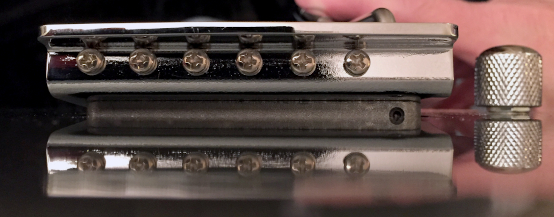
Down the Throat - Click to embiggen
IMPRESSIONS
Physical – While the first impression is of a super Strat, little differences begin to show themselves as you evaluate the guitar in your lap. Firstly, the guitar is robust and well-built. It feels more stout than a Strat. As you look it over and play it you also start to get the feeling that this guitar is smaller than a Strat, and it is. I’m sure that the smaller headstock and body and slightly narrower neck contribute to that impression. The guitar’s contours make it sit quite comfortably in the lap. The deep, smooth “V” neck profile is surprisingly comfortable in the hand and provides good support. The extended treble cutaway and the rounded neck heel shift that uncomfortable feeling of being cramped by the high end of the neck several frets up, which is quite welcome. Previously, I’d usually accommodated my short fingers by favoring Gibson's 24.75" scale but this guitar has taught me another way to accommodate them: The LK100D's narrower neck, 1.65” at the nut, helps me reach some of my longer string-to-string stretches despite the guitar’s longer scale. In bends, which I do a lot of, the shortened 4+2 headstock and flattened 12” radius keep the strings from feeling like long, rigid things that you fight against. You must remember that while bending, the feel of flexibility isn’t determined by the scale but by the free length of string between tuner and tailpiece and by the flexibility of the bridge. On that subject, the bridge is a vintage-esque, two-point trem bridge with individually-adjustable bent-steel saddles. The trem action is smooth and the bridge's resistance against the strings is firm in bends. The front-loaded pickups are directly mounted to the body. The guitar is delivered in a padded, Sterling-branded soft carry bag.
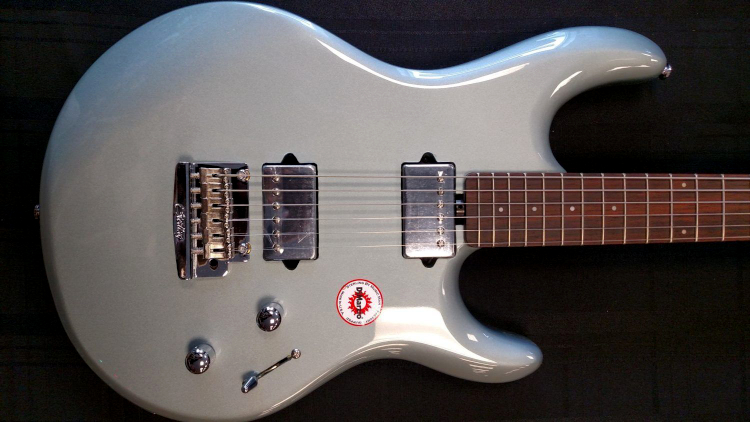
Click to embiggen
The guitar’s fit and finish are impeccable. The gloss on the body is smooth and glassy and edges are completely finished and buffed. In fact, all visible areas of the guitar are finished nicely. The satin finish on the neck is consistent and comfortable. The fingerboard is a nice chunk of dark brown rosewood with a single, slightly lighter streak. The medium-narrow, tall frets are leveled and dressed nicely and the intonation is spot-on. The shouldering on the neck is comfortably rounded. The Sterling guitars are built in Indonesia and receive their final set up at the Music Man headquarters in San Luis Obispo, California. They really seem to do a great job, especially at the very reasonable price point of this guitar.
Sound – This is a fascinating-sounding guitar. Steve’s design goals for the pickups were for them to have a full, meaty, “masculine” sound but still offer good articulation on the high end. That observation is interesting to me. While not courting any controversy, perhaps I can say that I and many around me grew up with some sort of perception that humbucking pickups were more masculine than single coil pickups. With that said, in the Transition™ humbuckers we indeed find a good, strong bottom end girth like a Gibson humbucker but also a high-end response that is more reminiscent of a Tele. Where Gibson humbuckers might be meat and potatoes and Fender single-coils might be seafood, perhaps with the Transition™ humbuckerss we have surf and turf. DiMarzio managed to produce a brilliant, sweet high-end sound as you pass the twelfth fret that isn’t shrill at all. From what I can tell, they accomplish this by having less midrange than typical Gibson humbuckers, allowing the treble and bass to shine. The guitar’s woods contribute as well. Basswood is known as a warm body wood. A maple neck tends to add some snap. A rosewood fingerboard tends to moderate that snap. In the end, the woods and pickups blend well. If I plug the guitar into a rig dialed in for a Gibson, I find myself backing off the treble a bit at the guitar, just like I would on a Tele. What I end up with is a really nice, wide-range sound with more gain and far less noise than you’d get on a Tele. The bridge pickup, which DiMarzio rates as a "high power" pickup, has a little more output than the ’57 Classic Plus pickup in the bridge position of my Gibson SG. DiMarzio rates the neck pickup as a "medium power" pickup and it is more down in Gibson range. A push-push knob on the volume control offers an additional 12db boost for leads. The Ernie Ball version of the guitar has a trim to adjust the amount of boost but this is deleted from the Sterling version. The guitar’s pickups are passive but both the boosted and un-boosted paths from the push-push switch pass through a buffer amp powered by a 9v battery in the back of the guitar. As a caveat: no battery, no signal, period.

Image Courtesy of Dawson's Music
SWITCHING
From neck to bridge switch positions:
- Full bridge humbucker, coils in series
- Pickups split, outside coils only, in parallel
- Both pickups in humbucker mode, coils in series, pickups parallel
- Pickups split, inside coils only, in parallel
- Full neck humbucker, coils in parallel
And the resulting sounds? When run into a driven amp, the guitar offers a full, gutsy, driving bridge pickup sound that hunkers down and moans nicely for lead. It offers a throaty, sweet neck position as well. Position three is a really nice blend of the bridge and neck sounds offering the bass of the neck and the high-end of the bridge. The split-coil sounds in positions two and four are bright and plinky with four being less nasal. As you might expect, the single-coil sounds are at a lower level than the humbucker sounds. The Ernie Ball version of the LUKE model provides an internal trim for the split-coil sounds but that feature is deleted from the Sterling version. In my case this isn’t a problem because those two single-coil sounds would tend to be rhythm sounds for me that I would want to be lower. However, engaging the boost control seems to work nicely to match between single-coil sounds and humbuckers.
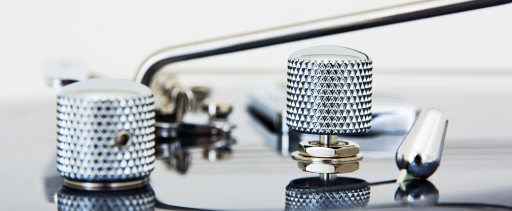
Image Courtesy of Ernie Ball
CONCLUSIONS
So, is the Sterling LK100D worth the entry fee? Absolutely. In fact, the quality and features are amazing for the price. This guitar is the best value I’ve seen at this price range, bar none, and I’ve tried out guitars from all the major brands in this range. The new version of the LK100D, the LUKE, seems to be the very same guitar minus the Transition™ pickups. It is offered in a couple of nice finish options that the LK100D wasn’t offered in, both of which feature a maple veneer to offer some flame. The difference in price between the LK100D and the LUKE is just about the amount it costs to install a set of Transition™ pickups, and you may exercise just that option. I can’t find a single tell-tale sign that this a medium, rather than high-priced, guitar. It is a beautiful guitar with lovely lines and very nice appointments. It is easy and fun to play and has a very useful sound pallette that inspires me. I’ve heard many opinions that the Sterling guitars are some of the best values out there and this example certainly upholds that impression. Go try out one at your local guitar store!
* Surprise!!! As it turns out, the LK100D is set up for Ernie Ball 2223 Super Slinky (.009s) strings from the factory! An info request to Sterling yeilded the spec sheet for the guitar. The Ernie Ball Music Man FAQ mentioned below says that the setup required for the tailpiece to offer Steve’s one-and-a-half-step upwards bend capability can only be achieved with .009s. By contrast, the spec sheet for the current Sterling LUKE model shows that it is spec’d with Regular Slinkys (.10).
** There’s lots of set-up info for Ernie Ball Music Man guitars available on the Music Man FAQ, HERE. Interestingly, though much of this info applies to Serling guitars, none of it is available over on the Sterling side of the site.
LK100D MODEL SPECS
- Basswood Body
- Maple Neck
- Rosewood Fingerboard
- Vintage Tremolo Bridge
- Chrome Hardware
- 25.5" (64.8cm) Scale Length
- 12" (30.5cm)Fingerboard Radius
- Deep V Neck Profile
- 22 Frets, Narrow
- 1.65"(42mm) Neck Width at Nut
- White Dot Fret Markers
- Dual Action Truss Rod
- Locking Tuning Machines
- 5 Bolt Pattern Neck Attachment
- 1 Push/Push Volume Boost, 1 Tone Control
- 5-way Toggle Pickup Selector Switching
- DiMarzio Steve Lukather signature Transition™ Humbucker Pickups, BRIDGE, NECK
- Ernie Ball Super Slinky (.009) Strings
- Deluxe Sterling by Music Man Bag
STERLING BY MUSIC MAN LUKE PAGE
= =
=







